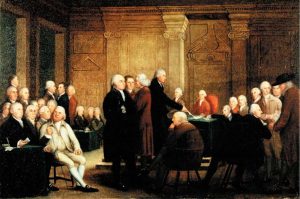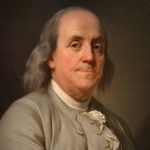
 During the years of growing pains for the United States, it was not considered a nation with any power, or in fact, a nation at all. The British wanted to keep he American Colonies under its power for tax purposes, and for the power that comes when a nation owns large areas of land around the globe. The young country…still under the bonds of British rule, was rebelling against what they considered tyranny, however, they would not get very far without military help coming from somewhere. So, on November 29, 1775, the Second Continental Congress, met in Philadelphia, to establish a Committee of Secret Correspondence. The committee’s goal was to provide European nations with a Patriot interpretation of events in Britain’s North American colonies, in the hope of soliciting aid for the American war effort. The committee consisted of Benjamin Franklin, Benjamin Harrison, John Dickinson, John Hay, and Robert Morris. Following the meeting, the committee instructed Silas Deane to meet with French Foreign Minister Charles Gravier, Count de Vergennes, to stress America’s need for military stores and assure the French that the colonies were moving toward “total separation” from Great Britain. Covert French aid began filtering into the colonies soon after the outbreak of hostilities in 1775, but it was not enough. The Americans had to figure out a way to get more aid.
During the years of growing pains for the United States, it was not considered a nation with any power, or in fact, a nation at all. The British wanted to keep he American Colonies under its power for tax purposes, and for the power that comes when a nation owns large areas of land around the globe. The young country…still under the bonds of British rule, was rebelling against what they considered tyranny, however, they would not get very far without military help coming from somewhere. So, on November 29, 1775, the Second Continental Congress, met in Philadelphia, to establish a Committee of Secret Correspondence. The committee’s goal was to provide European nations with a Patriot interpretation of events in Britain’s North American colonies, in the hope of soliciting aid for the American war effort. The committee consisted of Benjamin Franklin, Benjamin Harrison, John Dickinson, John Hay, and Robert Morris. Following the meeting, the committee instructed Silas Deane to meet with French Foreign Minister Charles Gravier, Count de Vergennes, to stress America’s need for military stores and assure the French that the colonies were moving toward “total separation” from Great Britain. Covert French aid began filtering into the colonies soon after the outbreak of hostilities in 1775, but it was not enough. The Americans had to figure out a way to get more aid.
Deane, a Connecticut delegate to the Continental Congress, left for France on the secret mission on March 3, 1776. He managed to negotiate for unofficial assistance from France, in the form of ships containing military supplies, and recruited Gilbert du Motier, the marquis de Lafayette to share his military expertise with the Continental Army’s officer corps. The aid helped some, but America needed a real commitment from France. That was not so easy to obtain, until after the arrival of the charming Benjamin Franklin in France in December 1776. Then, after the American victory at the Battle of Saratoga in October 1777, the French became convinced that it was worth backing the Americans in a formal treaty. On February 6, 1778, the Treaties of Amity and Commerce and Alliance were signed, and in May 1778 the Continental Congress ratified them.

 One month later, war between Britain and France formally began when a British squadron fired on two French ships. During the American Revolution, French naval fleets proved critical in the defeat of the British, which was assured after the Battle of Yorktown in October 1781. In reality, this was a spy thriller right out of the likes of James Bond, in that every step of this maneuver was critical to the survival of the United States of America, and everything pretty much went exactly as planned.
One month later, war between Britain and France formally began when a British squadron fired on two French ships. During the American Revolution, French naval fleets proved critical in the defeat of the British, which was assured after the Battle of Yorktown in October 1781. In reality, this was a spy thriller right out of the likes of James Bond, in that every step of this maneuver was critical to the survival of the United States of America, and everything pretty much went exactly as planned.


Leave a Reply